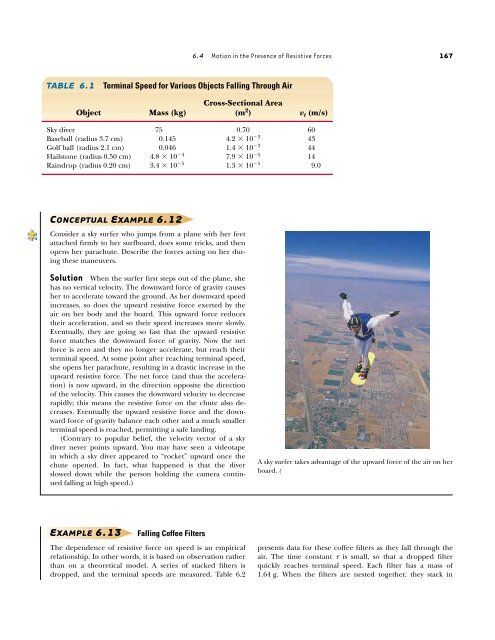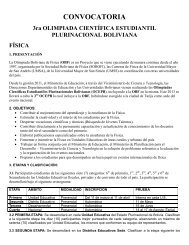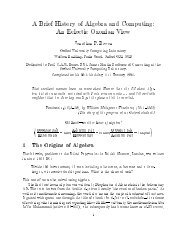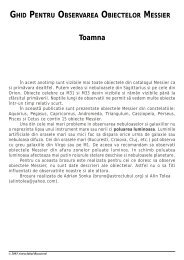Circular Motion and Other Applications of Newton's Laws
Circular Motion and Other Applications of Newton's Laws
Circular Motion and Other Applications of Newton's Laws
Create successful ePaper yourself
Turn your PDF publications into a flip-book with our unique Google optimized e-Paper software.
TABLE 6.1 Terminal Speed for Various Objects Falling Through Air<br />
6.4 <strong>Motion</strong> in the Presence <strong>of</strong> Resistive Forces 167<br />
Cross-Sectional Area<br />
Object Mass (kg) (m 2 ) v t (m/s)<br />
Sky diver 75 0.70 60<br />
Baseball (radius 3.7 cm) 0.145 4.2 � 10 �3 43<br />
Golf ball (radius 2.1 cm) 0.046 1.4 � 10 �3 44<br />
Hailstone (radius 0.50 cm) 4.8 � 10 �4 7.9 � 10 �5 14<br />
Raindrop (radius 0.20 cm) 3.4 � 10 �5 1.3 � 10 �5 9.0<br />
CONCEPTUAL EXAMPLE 6.12<br />
Consider a sky surfer who jumps from a plane with her feet<br />
attached firmly to her surfboard, does some tricks, <strong>and</strong> then<br />
opens her parachute. Describe the forces acting on her during<br />
these maneuvers.<br />
Solution When the surfer first steps out <strong>of</strong> the plane, she<br />
has no vertical velocity. The downward force <strong>of</strong> gravity causes<br />
her to accelerate toward the ground. As her downward speed<br />
increases, so does the upward resistive force exerted by the<br />
air on her body <strong>and</strong> the board. This upward force reduces<br />
their acceleration, <strong>and</strong> so their speed increases more slowly.<br />
Eventually, they are going so fast that the upward resistive<br />
force matches the downward force <strong>of</strong> gravity. Now the net<br />
force is zero <strong>and</strong> they no longer accelerate, but reach their<br />
terminal speed. At some point after reaching terminal speed,<br />
she opens her parachute, resulting in a drastic increase in the<br />
upward resistive force. The net force (<strong>and</strong> thus the acceleration)<br />
is now upward, in the direction opposite the direction<br />
<strong>of</strong> the velocity. This causes the downward velocity to decrease<br />
rapidly; this means the resistive force on the chute also decreases.<br />
Eventually the upward resistive force <strong>and</strong> the downward<br />
force <strong>of</strong> gravity balance each other <strong>and</strong> a much smaller<br />
terminal speed is reached, permitting a safe l<strong>and</strong>ing.<br />
(Contrary to popular belief, the velocity vector <strong>of</strong> a sky<br />
diver never points upward. You may have seen a videotape<br />
in which a sky diver appeared to “rocket” upward once the<br />
chute opened. In fact, what happened is that the diver<br />
slowed down while the person holding the camera continued<br />
falling at high speed.)<br />
EXAMPLE 6.13<br />
Falling C<strong>of</strong>fee Filters<br />
The dependence <strong>of</strong> resistive force on speed is an empirical<br />
relationship. In other words, it is based on observation rather<br />
than on a theoretical model. A series <strong>of</strong> stacked filters is<br />
dropped, <strong>and</strong> the terminal speeds are measured. Table 6.2<br />
A sky surfer takes advantage <strong>of</strong> the upward force <strong>of</strong> the air on her<br />
board. (<br />
presents data for these c<strong>of</strong>fee filters as they fall through the<br />
air. The time constant � is small, so that a dropped filter<br />
quickly reaches terminal speed. Each filter has a mass <strong>of</strong><br />
1.64 g. When the filters are nested together, they stack in










